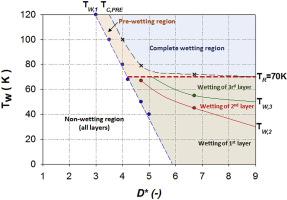Microporous and Mesoporous Materials ( IF 4.8 ) Pub Date : 2018-12-18 , DOI: 10.1016/j.micromeso.2018.12.023 Luisa Prasetyo , Quang K. Loi , Shiliang Johnathan Tan , D.D. Do , D. Nicholson

|
We have carried out extensive simulations of argon adsorption on substrates of different strengths to investigate the effects of temperature on the transition from non-wetting to wetting. For moderately weak substrates, pre-wetting in the so-called “thin-to-thick film” transition occurs. We show that at a microscopic level this is a transition from an adsorbate composed of clusters to one of adsorbed layers. At the wetting temperature (Tw), this transition occurs at the saturation vapour pressure, and Tw depends on the relative strength of the intermolecular interaction between adsorbate molecules and between the adsorbate and the adsorbent, and that Tw increases as the adsorbent strength decreases. The appropriate parameter to account for the role of temperature in the wetting transition is the ratio of the isosteric heat to the heat of condensation, which is a measure of the relative strength between adsorption and cluster formation. At temperatures greater than Tw, the adsorption mechanism is layer-by-layer wetting if the wetting temperature is lower than the roughening temperature (TR). On the other hand, if the wetting temperature is greater than TR the mechanism is either continuous wetting or pre-wetting, which then transitions to continuous wetting when the temperature is greater than the critical pre-wetting temperature. Our study shows that the transitions from non-wetting to pre-wetting to wetting, occur not only in the first adsorbate layer, but also in higher layers.
中文翻译:

温度对氩气在不同强度的基材上从团聚到成层的过渡的影响-润湿,预润湿和不润湿的参数图
我们已经对不同强度的基材上的氩气吸附进行了广泛的模拟,以研究温度对从非润湿性到润湿性转变的影响。对于中等强度的基材,会发生所谓的“薄至厚膜”过渡的预润湿。我们表明,在微观水平上,这是从由簇组成的被吸附物到被吸附层之一的过渡。在湿润温度(T w)时,这种转变发生在饱和蒸气压下,并且T w取决于被吸附物分子之间以及被吸附物和吸附剂之间的分子间相互作用的相对强度,以及T w随着吸附强度的降低而增加。考虑温度在润湿转变中的作用的合适参数是等构热与冷凝热之比,它是吸附和团簇形成之间相对强度的量度。在高于T w的温度下,如果润湿温度低于粗糙化温度(T R),则吸附机理是逐层润湿的。另一方面,如果润湿温度大于T R其机理是连续润湿或预润湿,然后在温度高于临界预润湿温度时转变为连续润湿。我们的研究表明,从非润湿到预润湿再到润湿的过渡不仅发生在第一吸附层上,而且还发生在较高的层上。











































 京公网安备 11010802027423号
京公网安备 11010802027423号